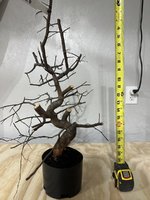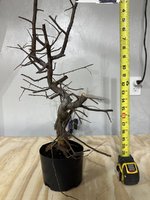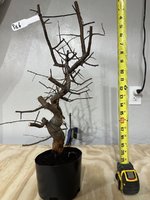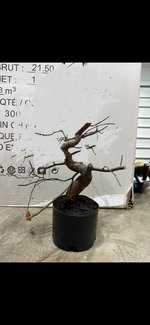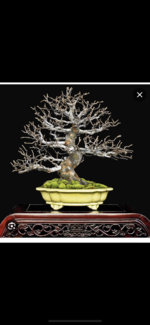Hello friends, I recently purchased this pre-bonsai field grown Chinese quince, and it has lots of curves and branching, with plenty of options. Any suggestions would be greatly appreciated. The first four pictures are all all four sides and then the last 2 pictures are design options that I drew last night. It would be a shame to cut the tree right in half, but I’m completely open to any options. I plan on building a grow box for this tree in the spring to fatten up the trunk some.
You are using an out of date browser. It may not display this or other websites correctly.
You should upgrade or use an alternative browser.
You should upgrade or use an alternative browser.
Chinese quince design help
- Thread starter johnl445
- Start date
Doogliebop
Mame
That looks incredibly promising. Great find.
I'm looking for pointers for mine so I'm not much help. Someone with sound advice will chime in soon hopefully.
I'm looking for pointers for mine so I'm not much help. Someone with sound advice will chime in soon hopefully.
WNC Bonsai
Masterpiece
My first reaction would be a cut back to about half the height just as you show in photo #6. I have 3 in my growing bed but don’t have the height issue as the deer browse it back each fall. I am finally moving them this coming spring to a deer free location which I dare not mention as they may be reading this!
Shibui
Imperial Masterpiece
It is never a shame to cut a tree in half if that's what is needed. Most field grown trees have been pruned with growth in mind. Now the new grower must prune with bonsai in mind and that can easily mean removing a lot of the growth that has fuelled trunk thickening.
I also like the look of pic 6 provided the trunk bends mostly have good front to back movement (always hard to work out from 2D photos) and branching starts in useful places and grows or can be bent into useful directions.
Because of the limitations of 2D viewing you will always need to be the final arbiter as the tree needs to be good in 3D
I also like the look of pic 6 provided the trunk bends mostly have good front to back movement (always hard to work out from 2D photos) and branching starts in useful places and grows or can be bent into useful directions.
Because of the limitations of 2D viewing you will always need to be the final arbiter as the tree needs to be good in 3D
Thank you @Shibui and @WNC Bonsai for the helpful feedback. Ok, so don’t be afraid to cut the tree in half. I’d still like to achieve a finish height of about 18” or so. The part of a bonsai that I’m still learning is, if I cut the tree in half but, keep it in the ground to grow vigorously, will the original portion of the trunk continue to get longer or will it stay at that height and just get fatter?It is never a shame to cut a tree in half if that's what is needed. Most field grown trees have been pruned with growth in mind. Now the new grower must prune with bonsai in mind and that can easily mean removing a lot of the growth that has fuelled trunk thickening.
I also like the look of pic 6 provided the trunk bends mostly have good front to back movement (always hard to work out from 2D photos) and branching starts in useful places and grows or can be bent into useful directions.
Because of the limitations of 2D viewing you will always need to be the final arbiter as the tree needs to be good in 3D
WNC Bonsai
Masterpiece
You will get new shoots popping on the old stem which can be selectively pruned and developed into ne branches or a new apex. This will in turn give you a smaller diameter upper trunk and some needed taper. The three I have tend not to naturally produce taper unless this is done. They just stay about the same diameter over much if their height.
Ok @WNC Bonsai , will the original trunk continue to elongate after a chop?
WNC Bonsai
Masterpiece
The trunk itself will not, however if you allow a new shoot towards or at the cut end to extend and become a new apex then that will in effect elongate the original trunk.Ok @WNC Bonsai , will the original trunk continue to elongate after a chop?
Shibui
Imperial Masterpiece
Not sure what concept you have in mind here.will the original trunk continue to elongate after a chop?
If I tie a swing on a tree branch for my kids to play on will the grandchildren still be able to reach that swing 30 or 40 years later or will it now be too high because the tree trunk has grown?
Will my kids need a longer ladder to reach the tree house I built when I was young?
Need to understand how trees grow. All trees grow taller from the top, not from the bottom.
You will chop the trunk lower. New shoots will emerge from the remaining trunk and branches. Those shoots will grow upward to make it taller. So the trunk will grow taller because of the new shoots that grow but the existing part of the trunk will only get fatter.
Where you want a tree of 18' it is usual to chop quite a bit lower than that initially to allow for the new shoots that will almost always grow up to form the new apex and crown of the tree.
SeanS
Omono
- Messages
- 1,564
- Reaction score
- 5,175
- USDA Zone
- 9b
@johnl445 here’s a diagram of what @Shibui explained above.
If you chop a tree at X height, the tree will usually produce new shoots from around the chop site (shoots in purple in diagram). We use these to grow the subsequent sections of trunk in order to create taper (gradual reduction in the trunk’s diameter/thickness as the tree goes up). However the original part of the trunk left over after the original chop will remain at X height, it does not elongate or get taller.
So as mentioned, chop lower than your intended finished height and use the new growth to grow the tree to your desired height, making multiple chops as time goes by in order to produce attractive taper instead of a tree that is all one thickness up to the top.
Imagine the swing @Shibui mentioned hanging from the first branch, it will remain at that height for the entire tree’s life.

If you chop a tree at X height, the tree will usually produce new shoots from around the chop site (shoots in purple in diagram). We use these to grow the subsequent sections of trunk in order to create taper (gradual reduction in the trunk’s diameter/thickness as the tree goes up). However the original part of the trunk left over after the original chop will remain at X height, it does not elongate or get taller.
So as mentioned, chop lower than your intended finished height and use the new growth to grow the tree to your desired height, making multiple chops as time goes by in order to produce attractive taper instead of a tree that is all one thickness up to the top.
Imagine the swing @Shibui mentioned hanging from the first branch, it will remain at that height for the entire tree’s life.

Wood
Chumono
Is this from Dylan Ferreira at Cedar Rose nursery? He's definitely grown a lot of nice trees
I think the ultimate height of the tree is probably correct, but I'll offer two counterpoints to the hard chop suggestion:
- Air layer the top off your hard cut. You'll be able to use the wonderful movement and taper of the top half even if it doesn't work for the current trunk
- Staged cutbacks. Cut to a larger height and silhouette than you intended, and the tree will produce smaller internodes because there are more buds/growing tips. Michael Hagedorn mentioned it in his last podcast, and I found this blog post afterwards: https://crataegus.com/2019/10/05/deciduous-early-development-part-i-japanese-maple/
Also, if you're planning on going to any BYOT workshops with a pro this year, this seems like excellent material to keep for that occasion
I think the ultimate height of the tree is probably correct, but I'll offer two counterpoints to the hard chop suggestion:
- Air layer the top off your hard cut. You'll be able to use the wonderful movement and taper of the top half even if it doesn't work for the current trunk
- Staged cutbacks. Cut to a larger height and silhouette than you intended, and the tree will produce smaller internodes because there are more buds/growing tips. Michael Hagedorn mentioned it in his last podcast, and I found this blog post afterwards: https://crataegus.com/2019/10/05/deciduous-early-development-part-i-japanese-maple/
Also, if you're planning on going to any BYOT workshops with a pro this year, this seems like excellent material to keep for that occasion
@Wood yes, this is a tree from Dylan. I purchased it last month.
I will make the chop taller than my preferred height, That’s good to know the benefits of doing this. I read up on that link that you sent. It feels that a lot of practicing bonsai is about showing discipline for patience, not making too many cuts at first, to make the tree look pretty because it’ll have a negative effect of a surge of unwanted growth with long internodes. the result of the tree being imbalanced with roots to foliage. It also stated, leaving some unwanted branches will help him grow/thicken the tree faster
I will make the chop taller than my preferred height, That’s good to know the benefits of doing this. I read up on that link that you sent. It feels that a lot of practicing bonsai is about showing discipline for patience, not making too many cuts at first, to make the tree look pretty because it’ll have a negative effect of a surge of unwanted growth with long internodes. the result of the tree being imbalanced with roots to foliage. It also stated, leaving some unwanted branches will help him grow/thicken the tree faster
Last edited:
Similar threads
- Replies
- 19
- Views
- 1K
- Replies
- 21
- Views
- 2K

